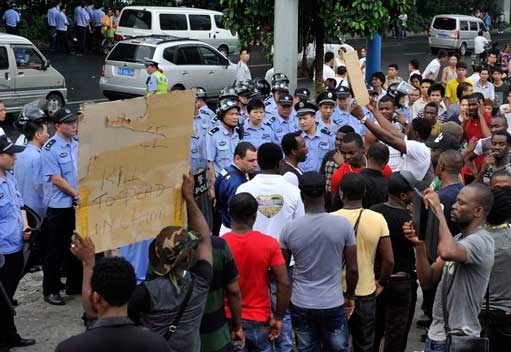
Strike Hard Against Immigration: China’s New Exit-Entry Law
Publication: China Brief Volume: 13 Issue: 23
By:

In July of this year, China enacted its first major reform to its immigration policy since 1986. Passed by the National People’s Congress Standing Committee in 2012, the Exit-Entry Administration Law, which has replaced the Law for Foreigners and the Law for Citizens, features harsher penalties for visa overstays and unauthorized work. This new law, along with China’s upcoming revisions to its permanent residency application system, makes abundantly clear the fact that China has little interest in becoming a receiving country for transnational migrants. Yet, as the country with the second highest GDP in the world, porous borders and strong incentives to maintain healthy diplomatic relations with the global South, it is necessary for China to rethink its piecemeal policies and opt for a more comprehensive strategy toward international immigration.
Although this is not the first time China has cracked down on visa applications—visa issuance was severely restricted to foreigners leading up to the 2008 Beijing Olympics—this is the first time that foreigners will face detention and investigation for overstaying their visas (up to sixty days “if the case is complicated”). Foreigners working illegally will now face detention (five to fifteen days) or monetary fines of up to 20,000 RMB ($3,260 USD). Previously, the penalty for unauthorized work did not exceed a monetary fine of 1,000 RMB ($163.00 USD). Companies and institutions that provide fake certificates or invitation letters to unqualified foreigners will be fined up to 10,000 RMB ($1,630.00 USD) per person, and be responsible for the cost of their deportation. The fines will not exceed 100,000 RMB ($16,290 USD), as opposed to 50,000 RMB ($8,145.00 USD) in the previous law. Lastly, foreigners who own companies and delay paying wages to workers will be prevented from leaving the country (China Daily, July 1).
Historically, China has not been a destination country for labor. For centuries, China has sent its workers abroad, as Chinese companies have in recent years in establishing operations in Africa. Yet significant inflows of labor have emerged over the past decade. According to a 2011 Brookings Report, China’s transnational migrants are increasing at an “unprecedented scale,” or ten percent annually since the year 2000, according to Yang Huanming, vice-minister of the Ministry of Public Security (Brookings, September 8, 2011; Xinhua, June 30, 2012). China’s 2010 census, the first to record the amount of foreigners residing in the country, documented approximately 594,000 foreigners living in China in 2010 (South China Morning Post, July 1; China National Bureau of Statistics, Major Figures on Residents from Hong Kong, Macao and Taiwan and Foreigners Covered by 2012 Population Census, April 29, 2011).
International enclaves can be found throughout the country, in such varied locations as Shanghai and Beijing Municipalities, Guangdong, Jiangsu, Fujian, Yunnan, Zhejiang, Shandong, and Liaoning Provinces, and Guangxi Zhuang Autonomous Region. Residents of international communities are of both legal and illegal status, and attempts to decipher how many people live permanently in these areas are often inconclusive (Brookings, September 8, 2011). For instance, it is estimated that between 20,000 and 100,000 Africans reside in Guangzhou’s thriving small-scale trade community, otherwise known as “Little Africa” (World Policy Journal, February 18, 2011). While China’s National Tourism Administration Agency collects figures on how many foreigners enter the country per year for tourism, family visits, meetings and employment (approximately 27 million in 2012), local registration authorities often fail to produce official statistics on permanent foreign residents (China National Tourism Administration, 2012 Statistics (by Entry Purpose), January 17; Eurasian Geography and Economics, 2009).
Narrow Path to Residency
China’s Nationality Law states that naturalization may be acquired through an application process, under the conditions that the applicants are relatives of Chinese nationals, have settled in China, or have “other legitimate reasons” (Nationality Law of the People’s Republic of China, 1980). Foreigners can also establish long-term residence in China through a permanent residency permit, otherwise known as the “Chinese green card,” which is not a step toward citizenship. However, one would be hard-pressed to find an official permanent resident or naturalized citizen anywhere in the country. Since 2004, when China began granting permanent residency permits to foreigners, only an approximate 5,000 people have been awarded the coveted permit, called the “hardest to get in the world” by the Southern Metropolis Daily (Southern Metropolis Daily, September 6, 2013; China Daily, November 19, 2012, October 17, 2012). The low number of permanent resident card holders is in no small part due to the fact that the program was and continues to be geared toward high-level personnel and overseas Chinese: employees who belong to companies that promote China’s economic, scientific and technological development, individuals who make relatively large direct investment in China (over $500,000 USD) or have made “outstanding contributions” that are of special importance to China, and relatives of Chinese citizens who plan on residing permanently in China (China Daily, August 21, 2004, October 16, 2006).
According to Qu Yunhai, deputy director of the Entry and Exit Administration Bureau, the Ministry of Public Security and the Ministry of Foreign Affairs are in the process of developing a new draft regulation that will feature lower requirements for green card applicants (China Daily, October 17, 2012). An expert privy to the ministry’s recent activities, Liu Guofu of the Beijing Institute of Technology, has said that the draft regulation will target immigrants in the technology field who have lived in China for ten consecutive years (China Daily, November 19, 2012). Both Qu and Liu’s remarks suggest that even with a relaxation in application requirements, the majority of foreign long-term residents of China will not be considered eligible for permanent residency status.
Effects of this law have already begun to receive media coverage. In August, Shanghai Daily reported that immigration authorities at Shanghai’s two airports have documented close to 500 cases of overstays since the law took effect in July. A Dutchman was the first to receive the maximum 10,000 RMB ($1,630.00 USD) fine, but Americans, Japanese, Canadians, French and Singaporeans came soon after, receiving fines that totaled 430,000 RMB ($70,053 USD) (Shanghai Daily, August 20).
However, little is known about the law’s impact on China’s population of foreigners who are not high-level personnel and do not plan to exit the country soon. Although it is illegal for individuals to hire foreigners, it is becoming common practice in metropolises such as Beijing, Shanghai and Guangzhou for households to hire Filipino maids, who enter the country on tourist visas and either reside illegally or attain business visas through agencies once they expire (China Daily, February 11, 2011; Beijing Today, August 13, 2010). Despite the risk of being deported, Filipinos are attracted to China’s prevailing salary of 4,000 RMB ($650.00 USD) per month. It is significantly higher than the $450.00 USD they receive in Singapore, where the majority of Filipino domestic workers are currently located (Jakarta Globe, June 2, 2012). Guangzhou, Shenzhen, and Yiwu are home to the world’s largest trading hubs for small-scale commodities, attracting long-term traders mainly from Africa, South Asia and the Middle East (Business Insider, November 3, 2011). The One Child policy has also impacted transnational migration to China. The high ratio of males to females has led to a demand for “foreign brides,” who are trafficked into China from countries such as Russia, North Korea, Vietnam, Laos, and Myanmar (Brookings, September 8, 2011).
Stability and Soft Power
Without a plan for the development of a comprehensive approach to international immigration, China has had to rely on a cocktail of regulatory mechanisms, addressing issues as they arise. Immigration control has proved especially difficult in Guangzhou, where the post-2008 limits on long-term visa issuance spawned a black market for “genuine,” or year-long, visas (The Globe and Mail, August 23, 2012). In 2009, during a police raid on illegal residents, two Nigerians attempting to escape arrest threw themselves through a window. Both were seriously injured, and rumors of their deaths fueled Guangzhou’s first-ever immigrant riot. In response to this, Ojukwu Emma, president of the Nigerian community association in Guangzhou, signed an “amnesty agreement” with the local Public Security Bureau, promising to assist the police with immigration control in return for the promise that overstayers would be allowed to return to China legally after paying their visa-related fines (The Globe and Mail, August 23, 2012). Yet, four years later a second riot broke out, this time over the death of Elebechi Celestine, a Nigerian trader who died in custody following an argument with a taxi driver. With the policy of social stability maintenance (weiwen) still a top priority for China’s president Xi Jinping and the rest of the Chinese leadership, China is likely to make efforts to move away from addressing international immigration on a case by case basis (Brookings, September 26).
It is also important to view flare-ups in Guangzhou in the context of China’s diplomatic and economic relationships with Africa. China is now Africa’s largest trading partner (Carnegie Endowment for International Peace, February 9, 2012). In a white paper on “China-Africa Economic and Trade Cooperation” published by the State Council in August of this year, “promoting South-South cooperation” was cited as one of China’s primary achievements in the Sino-Africa relationship over the past several years (Xinhua, August 29). However, it has faced mixed receptions in African countries. In an open letter to the Financial Times in March 2013, Lamido Sanusi, the Governor of the Central Bank of Nigeria, criticized China for taking Nigeria’s primary goods and selling back manufactured products, calling these practices “a new form of imperialism” (Financial Times, March 11). Sanusi’s plea to Nigerians to “wake up to the realities of their romance with China” is indicative of larger tensions that may threaten China’s thriving export trade with the country and the greater continent (see Carnegie Endowment for International Peace, February 9, 2012).
In recent months, China has shown signs that it will confront its migration challenges with pragmatism rather than force. In July of 2013, following a visit to China, Nigerian president Goodluck Jonathan announced the approval of a Nigerian consulate in Guangzhou, answering a request that Nigerians in the area have been making for years (The Guardian Nigeria, July 21). In China’s southern border region, where President Xi and Premier Li Keqiang have plans to strengthen economic ties, proactive efforts to manage border crossings have begun to take shape (South China Morning Post, October 12). In Dongxing, at the China-Vietnam border, the Chinese government recently established a free trade zone to accommodate the 7,000 Vietnamese traders who cross the border every day. A similar situation has been set up in Ruili, China’s border city with Myanmar, which accommodates approximately 30,000 cross-border workers across multiple industries. China’s official news outlets have described these free trade zones as models for the future of China-ASEAN cultural and economic exchange (Xinhua, August 19).
Conclusion
As the experiences of the United States and the European Union have shown, transnational migration is not an easy pill to swallow. However, according to the recently released UN Department of Economic and Social Affairs’ International Migration Policies 2013, a summary of migration policies in over 190 countries, 91 percent of “developed” countries have established integration policies for international immigration. China belongs to the majority (53 percent) of “developing” countries that lack policies geared to integrate non-nationals into their respective societies (UN, International Migration Policies 2013, September; Law and Border, September 7). While China’s own internal migrant population of 236 million will take first priority over external migrants, it is in China’s best interest to take account of the fact that its not-so-new role in the world order will inevitably lead to a greater influx of people in search of jobs and new lives (Xinhua, September 10). Before these proverbial ships arrive, the government may want to consider how it can avoid pitfalls in dealing with the world’s floating population.





